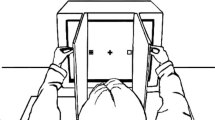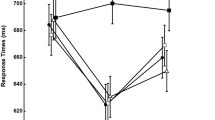Abstract
The endogenous orienting of spatial attention has been studied with both informative central cues and informative peripheral cues. Central cues studies are difficult to compare with studies that have used uninformative peripheral cues due to the differences in stimulus presentation. Moreover, informative peripheral cues attract both endogenous and exogenous attention, thus making it difficult to disentangle the contribution of each process to any behavioural results observed. In the present study, we used an informative peripheral cue (either tactile or visual) that predicted that the target would appear (in different blocks of trials) on either the same or opposite side as the cue. By using this manipulation, both expected and unexpected trials could either be exogenously cued or uncued, thus making it possible to isolate expectancy effects from cuing effects. Our aim was to compare the endogenous orienting of spatial attention to tactile (Experiment 1) and to visual targets (Experiment 2) under conditions of intramodal and crossmodal spatial cuing. The results suggested that the endogenous orienting of spatial attention should not be considered as being a purely supramodal phenomenon, given that significantly larger expectancy effects were observed in the intramodal cuing conditions than in the crossmodal cuing conditions in both experiments.




Similar content being viewed by others
Notes
In the present paper, cued and uncued locations refer to target locations preceded or not by a stimulus (the cue) at that spatial location, while expected and unexpected locations refer to locations where the participants endogenously expect the target to occur (due to verbal instructions and target probability manipulations).
References
Berlucchi G (2006) Inhibition of return: a phenomenon in search of a mechanism and a better name. Cogn Neuropsychol 23:1065–1074
Briand KA (1998) Feature integration and spatial attention: more evidence of a dissociation between endogenous and exogenous orienting. J Exp Psychol Hum Percept Perform 24:1243–1256
Briand KA, Klein RM (1987) Is Posner’s “beam” the same as Treisman’s “glue”? On the relation between visual orienting and feature integration theory. J Exp Psychol Hum Percept Perform 13:228–241
Buchtel HA, Butter CM (1988) Spatial attentional shifts: implications for the role of polysensory mechanisms. Neuropsychologia 26:499–509
Butter CM, Buchtel HA, Santucci R (1989) Spatial attentional shifts: further evidence for the role of polysensory mechanisms using visual and tactile stimuli. Neuropsychologia 27:1231–1240
Chambers CD, Stokes MG, Mattingley JB (2004) Modality-specific control of strategic spatial attention in parietal cortex. Neuron 44:925–930
Chica AB, Lupiáñez J (2004) Inhibition of return without return of attention. Psicothema 16:248–254
Chica AB, Lupiáñez J, Bartolomeo P (2006) Dissociating inhibition of return from the endogenous orienting of spatial attention: task set modulation. Cogn Neuropsychol 23:1015–1034
Cohen JC, Bolanowski SJ, Verillo RT (2005) A direct comparison of exogenous and endogenous inhibition of return and selective attention mechanisms in the somatosensory system. Somatosens Motor Res 22:269–279
Driver J, Spence C (1994) Spatial synergies between auditory and visual attention. In: Umiltà C, Moscovitch M (eds) Attention and performance XV: conscious and nonconcious information processing. MIT Press, Cambridge, pp 311–331
Eimer M (2000) The time course of spatial orienting elicited by central and peripheral cues: evidence from event-related brain potentials. Biol Psychol 53:253–258
Funes MJ, Lupiáñez J, Milliken B (2005) The role of spatial attention and other processes on the magnitude and time course of cueing effects. Cogn Process 6:98–116
Funes MJ, Lupiáñez J, Milliken B (2006) Separate mechanisms recruited by exogenous and endogenous spatial cues: evidence from a spatial Stroop paradigm. J Exp Psychol Hum Percept Perform (in press)
Harrar V, Harris L (2005) Simultaneity constancy: detecting events with touch and vision. Exp Brain Res 166:465–473
Harvey N (1980) Non-informative effects of stimuli functioning as cues. Q J Exp Psychol 32A:413–425
Klein RM (2000) Inhibition of return. Trend Cogn Sci 4:138–147
Klein RM (2004) On the control of visual orienting. In: Posner MI (ed) Cognitive neuroscience of attention. Guilford Press, New York, pp 29–44
Klein RM, Shore DI (2000) Relations among modes of visual orienting. In: Monsell S, Driver J (eds) Attention and performance XVIII: control of cognitive processes. MIT Press, Cambridge, pp 195–208
Klein RM, Brennan M, D’Aloisio A, D’Entremont B, Gilani A (1987) Covert cross-modality orienting of attention. (Unpublished data)
Lupiáñez J, Weaver B (1998) On the time course of exogenous cueing effects: a commentary on Tassinari et al. (1994). Vision Res 38:1621–1623
Lupiañez J, Decaix C, Siéroff E, Chokron S, Milliken B, Bartolomeo P (2004) Independent effects of endogenous and exogenous spatial cueing: inhibition of return at endogenously attended target locations. Exp Brain Res 159:447–457
Miller J (1988) A warning about median reaction time. J Exp Psychol Hum Percept Perform 13:539–543
Mondor TA, Amirault KJ (1998) Effect of same- and different-modality spatial cues on auditory and visual target identification. J Exp Psychol Hum Percept Perform 24:745–755
Müller HJ, Findlay JM (1988) The effect of visual attention on peripheral discrimination thresholds in single and multiple element displays. Acta Psychologica 69:129–155
Müller HJ, Rabbitt PM (1989). Reflexive and voluntary orienting of visual attention: time course of activation and resistance to interruption. J Exp Psychol Hum Percept Perform 15:315–330
Pashler HE (1998) The psychology of attention. MIT Press, Cambridge
Posner MI (1978) Chronometric explorations of mind. Erlbaum, Hillsdale
Posner MI (1980) Orienting of attention. Q J Exp Psychol 32A:3–25
Posner MI, Cohen Y, Rafal RD (1982) Neural systems control of spatial orienting. Philos Trans R Soc Lond B 298:187–198
Prinzmetal W, McCool C, Park S (2005) Attention: reaction time and accuracy reveal different mechanisms. J Exp Psychol Gen 134:73–92
Rodway P (2005) The modality shift effect and the effectiveness of warning signals in different modalities. Acta Psychologica 120:199–226
Ruz M, Lupiáñez J (2002). A review of attentional capture: on its automaticity and sensitivity to endogenous control. Psicológica 23:283–309
Schneider W, Eschman A, Zuccolotto A (2002) E-prime user’s guide. Psychology Software Tools Inc, Pittsburg
Spence C J, Driver J (1994) Covert spatial orienting in audition: exogenous and endogenous mechanisms. J Exp Psychol Hum Percept Perform 20:555–574
Spence C, Driver J (1996) Audiovisual links in endogenous covert spatial attention. J Exp Psychol Hum Percept Perform 22:1005–1030
Spence C, Driver J (eds) (2004) Crossmodal space and crossmodal attention. Oxford University Press, Oxford
Spence C, Nicholls MER, Gillespie N, Driver J (1998) Cross-modal links in exogenous covert spatial orienting between touch, audition, and vision. Percept Psychophys 60:544–557
Spence C, Pavani F, Driver J (2000) Crossmodal links between vision and touch in covert endogenous spatial attention. J Exp Psychol Hum Percept Perform 26:1298–1319
Spence C, Nicholls MER, Driver J (2001a) The cost of expecting events in the wrong sensory modality. Percept Psychophys 63:330–336
Spence C, Shore DI, Klein RM (2001b) Multisensory prior entry. J Exp Psychol Gen 130:799–832
Tassinari G, Campara D (1996) Consequences of covert orienting to non-informative stimuli of different modalities: a unitary mechanism? Neuropsychologia 34:235–245
Turatto M, Benso F, Galfano G, Umiltà C (2002) Non-spatial attentional shifts between audition and vision. J Exp Psychol Hum Percept Perform 28:628–639
Turatto M, Galfano G, Bridgeman B, Umiltà C (2004) Space-independent modality-driven attentional capture in auditory, tactile and visual systems. Exp Brain Res 155:301–310
Warner CB, Juola JF, Koshino H (1990) Voluntary allocation versus automatic capture of visual attention. Percept Psychophys 48:243–251
Yantis S, Jonides J (1990) Abrupt visual onsets and selective attention: voluntary versus automatic allocation. J Exp Psychol Hum Percept Perform 16:121–134
Acknowledgments
This research was supported by the Spanish Ministerio de Educación y Ciencia (predoctoral grant—AP-2004–1509—to the first author, and Research Project—BSO2002-04308-C02-02- to the third author) and the University of Granada (Becas del plan propio para estancias breves en otros centros de investigación) to the first author. Please direct correspondence concerning this article to: Ana Chica, Departamento de Psicología Experimental y Fisiología del Comportamiento, Facultad de Psicología, Universidad de Granada, Campus Universitario de Cartuja s/n, 18071-Granada, Spain. E-mail: anachica@ugr.es
Author information
Authors and Affiliations
Corresponding author
Additional information
An erratum to this article is available at http://dx.doi.org/10.1007/s00221-007-0900-9.
Rights and permissions
About this article
Cite this article
Chica, A.B., Sanabria, D., Lupiáñez, J. et al. Comparing intramodal and crossmodal cuing in the endogenous orienting of spatial attention. Exp Brain Res 179, 353–364 (2007). https://doi.org/10.1007/s00221-006-0798-7
Received:
Accepted:
Published:
Issue Date:
DOI: https://doi.org/10.1007/s00221-006-0798-7




